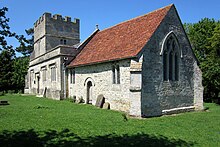|
St Bartholomew's Church, Furtho
St Bartholomew's Church is a redundant Anglican church in the former village of Furtho, Northamptonshire, England. It is recorded in the National Heritage List for England as a designated Grade II* listed building,[2] and is under the care of the Churches Conservation Trust.[3] Once medieval village, Furtho became deserted following enclosures that began in the early 16th century and were completed by Thomas Furtho in the 1570s.[1] All that remains in the vicinity of the church is a farm and a dovecote.[3] HistoryThe church dates from the 12th century, with additions and alterations in the 14th century. It was substantially rebuilt in about 1620 and was restored in 1870.[2] It ceased to be a parish church in 1920.[3] During the Second World War the church was used for storage of the archives of the Northampton Record Society, and during that time all the windows were destroyed by a bomb.[4] The church was declared redundant on 16 May 1989, and was vested in the Churches Conservation Trust on 7 June 1990.[5] ArchitectureExteriorSt Bartholomew's is constructed in limestone. The roof of the nave is in slate, and the roofs of the chancel and tower are tiled. Its plan consists of a three-bay nave, a two-bay chancel and a west tower. The tower is built partly within the west end of the nave. It is in two stages, and has diagonal buttresses and a pyramidal roof. In the lower stage is a three-light west window, and the upper stage has three-light bell openings. The parapet is battlemented. The nave contains three-light, arched, mullioned windows. There are Tudor arched doorways in both the north and south walls. On the east gable is a finial. The east window has three lights. In the south wall of the chancel is a pair of two-light windows with Decorated tracery, and a round-arched priest's door.[2] InteriorIn the chancel is a trefoil-headed piscina and a tomb recess. On each side of the east window is a bracket for an image.[2] Also in the chancel is a marble memorial to Anthony Furtho, who died in 1558, and his two wives, and a monument to Edmund Arnold dated 1676.[4] The octagonal font is small and dates from the 17th century.[2] See alsoReferences
|
||||||||||||||||||||||||||||||||||||||||||||||

